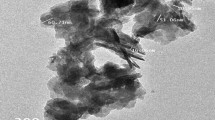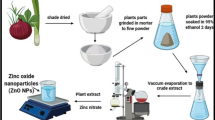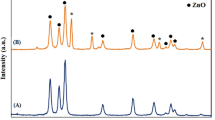Abstract
For many years, researchers were looking for new antibacterial substances to deal with hospital infections and especially resistant infections. Nanoparticles attracted much attentions because of their very small size that increases the surface to capacity ratio and consequently increase chemical activity. In this study, the antibacterial effects of silver, copper oxide, nickel oxide, and titanium dioxide nanoparticles were studied on Proteus vulgaris, as a bacterium involved in the resistant hospital infections. The capability of nanoparticles to inhibit the growth of bacteria was assessed via 9 different methods including cylinder, disk, and well-diffusion, spot test, MBC, MIC, liquid inhibitory action test, diffusion, and assessing the effects of nanoparticles on a 24-h culture. Based on the results, copper oxide and silver nanoparticles had high antibacterial effects on P. vulgaris in both liquid and solid cultures, respectively. However, nickel oxide and titanium dioxide nanoparticles only had a weak effect on the inhibition of bacterial growth in the liquid culture. CuO and Ag NPs could release ions and consequently produce free radicals, disturb the equilibrium of electrons between electron donor groups and inactivate enzymes and DNA of the organisms. Moreover, they triggered holes in the bacterial membrane to disturb cellular ion equilibrium. So, they can be used to inhibit the growth of pathogens. Besides, further studies have shown that they could be used as a supplementary treatment and/or in combination with other drugs to cure infections caused by P. vulgaris.




Similar content being viewed by others
References
Eriksen HM, Elstrøm P, Harthug S, Akselsen PE (2005) Infection control in long-term care facilities for the elderly. Tidsskr den Nor laegeforening Tidsskr Prakt Med ny raekke 125(13):1835–1837
Collins AS (2008) Preventing health care–associated infections. In: Patient safety and quality: an evidence-based handbook for nurses. Agency for Healthcare Research and Quality (US)
Ramsay JWA et al (1989) Biofilms, bacteria and bladder catheters a clinical study. Br J Urol 64(4):395–398
Liedl B (2001) Catheter-associated urinary tract infections. Curr Opin Urol 11(1):75–79
Gul N, Ozkorkmaz EG, Kelesoglu I, Ozluk A (2013) An ultrastructural study, effects of Proteus vulgaris OX19 on the rabbit spleen cells. Micron 44:133–136
Grobbel M et al (2007) Antimicrobial susceptibility of Klebsiella spp. and Proteus spp. from various organ systems of horses, dogs and cats as determined in the BfT-GermVet monitoring program 2004–2006. Berl Munch Tierarztl Wochenschr 120(9–10):402–411
O’Fallon E, Gautam S, D’Agata EMC (2009) Colonization with multidrug-resistant gram-negative bacteria: prolonged duration and frequent cocolonization. Clin Infect Dis 48(10):1375–1381
Shittu OB, Olaitan JO, Amus TS (2008) Physico-chemical and bacteriological analyses of water used for drinking and swimming purposes in Abeokuta, Nigeria” African. J Biomed Res. https://doi.org/10.4314/ajbr.v11i3.50739
A. C. Gales, H. S. Sader, R. N. Jones, S. P. Group (2002) Urinary tract infection trends in Latin American hospitals: report from the SENTRY antimicrobial surveillance program (1997–2000). Diagn Microbiol Infect Dis 44(3):289–299
Farrell D, Morrissey I, De Rubeis D, Robbins M, Felmingham D (2003) A UK multicentre study of the antimicrobial susceptibility of bacterial pathogens causing urinary tract infection. J Infect 46(2):94–100
Pape L, Gunzer F, Ziesing S, Pape A, Offner G, Ehrich JH (2004) Bacterial pathogens, resistance patterns and treatment options in community acquired pediatric urinary tract infection. Klin Padiatr 216(2):83–86
Adjei O, Opoku C (2004) Urinary tract infections in African infants. Int J Antimicrob Agents 24:32–34
Kanani M, Shahi M, Shahabi SH, Madani SH (2010) The survey of antibiotic resistance in gram negative bacilli, isolated from urine culture specimens, Imam Reza Hospital-Kermanshah. J Urmia Univ Med Sci 21(1):80–86
Matsukawa M, Kunishima Y, Takahashi S, Takeyama K, Tsukamoto T (2005) Bacterial colonization on intraluminal surface of urethral catheter. Urology 65(3):440–444
Jacobsen SM, Shirtliff ME (2011) Proteus mirabilis biofilms and catheter-associated urinary tract infections. Virulence 2(5):460–465
Vega-Jiménez AL, Vázquez-Olmos AR, Acosta-Gío E, and Álvarez-Pérez MA (2019) In vitro antimicrobial activity evaluation of metal oxide nanoparticles. In: Nanoemulsions-properties, fabrications and applications. IntechOpen
Khatoon N, Alam H, Khan A, Raza K, Sardar M (2019) Ampicillin silver nanoformulations against multidrug resistant bacteria. Sci Rep 9(1):6848
Azam A, Ahmed AS, Oves M, Khan MS, Memic A (2012) Size-dependent antimicrobial properties of CuO nanoparticles against gram-positive and-negative bacterial strains. Int J Nanomed 7:3527
Beranová J et al (2014) Sensitivity of bacteria to diamond nanoparticles of various size differs in gram-positive and gram-negative cells. FEMS Microbiol Lett 351(2):179–186
Yu B, Leung KM, Guo Q, Lau WM, Yang J (2011) Synthesis of Ag–TiO2 composite nano thin film for antimicrobial application. Nanotechnology 22(11):115603
Khashan KS, Sulaiman GM, Abdulameer FA (2016) Synthesis and antibacterial activity of CuO nanoparticles suspension induced by laser ablation in liquid. Arab J Sci Eng 41(1):301–310
Bogdanović U, Lazić V, Vodnik V, Budimir M, Marković Z, Dimitrijević S (2014) Copper nanoparticles with high antimicrobial activity. Mater Lett 128:75–78
Mamonova I (2013) Study of the antibacterial action of metal nanoparticles on clinical strains of gram negative bacteria. World J Med Sci 8(4):314
Kim JS et al (2007) Antimicrobial effects of silver nanoparticles. Nanomed Nanotechnol Biol Med 3(1):95–101
Legan JD, Vandeven MH, Dahms S, Cole MB (2001) Determining the concentration of microorganisms controlled by attributes sampling plans. Food Control 12(3):137–147
Armbruster CE, Mobley HLT (2002) Proteus species. Proteus - infectious disease and antimicrobial agents. http://www.antimicrobe.org/b226.asp
Ahamed M, Alhadlaq HA, Khan MA, Karuppiah P, Al-Dhabi NA (2014) Synthesis, characterization, and antimicrobial activity of copper oxide nanoparticles. J Nanomater 2014:17
Shrivastava S, Bera T, Roy A, Singh G, Ramachandrarao P, Dash D (2007) Characterization of enhanced antibacterial effects of novel silver nanoparticles. Nanotechnology 18(22):225103
Padil VVT, Černík M (2013) Green synthesis of copper oxide nanoparticles using gum karaya as a biotemplate and their antibacterial application. Int J Nanomed 8:889
Yoshida K, Tanagawa M, Matsumoto S, Yamada T, Atsuta M (1999) Antibacterial activity of resin composites with silver-containing materials. Eur J Oral Sci 107(4):290–296
Khashan KS, Sulaiman GM, Hamad AH, Abdulameer FA, Hadi A (2017) Generation of NiO nanoparticles via pulsed laser ablation in deionised water and their antibacterial activity. Appl Phys A 123(3):190
Duffy LL, Osmond-McLeod MJ, Judy J, King T (2018) Investigation into the antibacterial activity of silver, zinc oxide and copper oxide nanoparticles against poultry-relevant isolates of Salmonella and Campylobacter. Food Control 92:293–300
Heinlaan M, Ivask A, Blinova I, Dubourguier H-C, Kahru A (2008) Toxicity of nanosized and bulk ZnO, CuO and TiO2 to bacteria Vibrio fischeri and crustaceans Daphnia magna and Thamnocephalus platyurus. Chemosphere 71(7):1308–1316
Suresh S, Karthikeyan S, Saravanan P, Jayamoorthy K (2016) Comparison of antibacterial and antifungal activities of 5-amino-2-mercaptobenzimidazole and functionalized NiO nanoparticles. Karbala Int J Mod Sci 2(3):188–195
Das D, Nath BC, Phukon P, Dolui SK (2013) Synthesis and evaluation of antioxidant and antibacterial behavior of CuO nanoparticles. Colloids Surf B Biointerfaces 101:430–433
Arora B, Murar M, Dhumale V (2015) Antimicrobial potential of TiO2 nanoparticles against MDR Pseudomonas aeruginosa. J Exp Nanosci 10(11):819–827
Wikler MA (2009) Methods for dilution antimicrobial susceptibility test for bacteria that grow aerobically. Approv. Stand. M7-A8
Rajgovind GS, Gupta DK, Jasuja ND, Joshi SC (2015) Pterocarpus marsupium derived phyto-synthesis of copper oxide nanoparticles and their antimicrobial activities. J Microb Biochem Technol 7:140–144
Chudasama B, Vala AK, Andhariya N, Mehta RV, Upadhyay RV (2010) Highly bacterial resistant silver nanoparticles: synthesis and antibacterial activities. J Nanopart Res 12(5):1677–1685
Besinis A, De Peralta T, Handy RD (2014) The antibacterial effects of silver, titanium dioxide and silica dioxide nanoparticles compared to the dental disinfectant chlorhexidine on Streptococcus mutans using a suite of bioassays. Nanotoxicology 8(1):1–16
Ruparelia JP, Chatterjee AK, Duttagupta SP, Mukherji S (2008) Strain specificity in antimicrobial activity of silver and copper nanoparticles. Acta Biomater 4(3):707–716
Eshed M, Lellouche J, Gedanken A, Banin E (2014) A Zn-Doped CuO nanocomposite shows enhanced antibiofilm and antibacterial activities against streptococcus mutans compared to nanosized CuO. Adv Funct Mater 24(10):1382–1390
Paul D, Neogi S (2019) Synthesis, characterization and a comparative antibacterial study of CuO, NiO and CuO-NiO mixed metal oxide. Mater Res Express 6(5):55004
Huh AJ, Kwon YJ (2011) ‘Nanoantibiotics’: a new paradigm for treating infectious diseases using nanomaterials in the antibiotics resistant era. J Control Release 156(2):128–145
Ren G, Hu D, Cheng EWC, Vargas-Reus MA, Reip P, Allaker RP (2009) Characterisation of copper oxide nanoparticles for antimicrobial applications. Int J Antimicrob Agents 33(6):587–590
Cronholm P et al (2013) Intracellular uptake and toxicity of Ag and CuO nanoparticles: a comparison between nanoparticles and their corresponding metal ions. Small 9(7):970–982
Karlsson HL, Cronholm P, Gustafsson J, Moller L (2008) Copper oxide nanoparticles are highly toxic: a comparison between metal oxide nanoparticles and carbon nanotubes. Chem Res Toxicol 21(9):1726–1732
Yoon K-Y, Byeon JH, Park J-H, Hwang J (2007) Susceptibility constants of Escherichia coli and Bacillus subtilis to silver and copper nanoparticles. Sci Total Environ 373(2–3):572–575
Morones JR et al (2005) The bactericidal effect of silver nanoparticles. Nanotechnology 16(10):2346
Santhoshkumar A, Kavitha HP, Suresh R (2017) Preparation, characterization and antibacterial activity of NiO nanoparticles. Asian J Chem 29(2):239
Subhapriya S, Gomathipriya P (2018) Green synthesis of titanium dioxide (TiO2) nanoparticles by Trigonella foenum-graecum extract and its antimicrobial properties. Microb Pathog 116:215–220
Thandapani K et al (2018) Enhanced larvicidal, antibacterial, and photocatalytic efficacy of TiO 2 nanohybrids green synthesized using the aqueous leaf extract of Parthenium hysterophorus. Environ Sci Pollut Res 25(11):10328–10339
Velhal SG, Kulakrni SD, Jaybhaye RG (2014) Titanium dioxide nanoparticles for control of microorganisms. Int J Res Chem Env 4:192–198
Santhoshkumar T et al (2014) Green synthesis of titanium dioxide nanoparticles using Psidium guajava extract and its antibacterial and antioxidant properties. Asian Pac J Trop Med 7(12):968–976
Azam A, Ahmed AS, Oves M, Khan MS, Habib SS, Memic A (2012) Antimicrobial activity of metal oxide nanoparticles against gram-positive and gram-negative bacteria: a comparative study. Int J Nanomed 7:6003
Wang Z et al (2010) Anti-microbial activities of aerosolized transition metal oxide nanoparticles. Chemosphere 80(5):525–529
Van Dong P, Ha CH, Kasbohm J (2012) Chemical synthesis and antibacterial activity of novel-shaped silver nanoparticles. Int Nano Lett 2(1):9
Jeong J, Kim J, Seok SH, Cho W-S (2016) Indium oxide (In2 O3) nanoparticles induce progressive lung injury distinct from lung injuries by copper oxide (CuO) and nickel oxide (NiO) nanoparticles. Arch Toxicol 90(4):817–828
Ghodake G, Lee DS (2011) Biological synthesis of gold nanoparticles using the aqueous extract of the brown algae Laminaria japonica. J Nanoelectron Optoelectron 6(3):268–271
Zhang X, Zhang X, Wang S, Liu M, Tao L, Wei Y (2013) Surfactant modification of aggregation-induced emission material as biocompatible nanoparticles: facile preparation and cell imaging. Nanoscale 5(1):147–150
Munger MA et al (2015) Assessing orally bioavailable commercial silver nanoparticle product on human cytochrome P450 enzyme activity. Nanotoxicology 9(4):474–481
Baptista PV et al (2018) Nano-strategies to fight multidrug resistant bacteria—‘a battle of the titans’. Front Microbiol 9:1441
Shiraishi Y, Hirai T (2008) Selective organic transformations on titanium oxide-based photocatalysts. J Photochem Photobiol C Photochem Rev 9(4):157–170
Acknowledgements
This research was supported by Islamic Azad University of Urmia and conducted in the microbiology laboratory. We are also grateful to Dr. Zahra Morad pour (Department of Pharmaceutical Biotechnology, Faculty of Pharmacy, Urmia University of Medical Sciences, Urmia, Iran) and Dr. Abdollah Ghasemian (Department of Pharmaceutical Biotechnology, Faculty of Pharmacy, Urmia University of Medical Sciences, Urmia, Iran) for helping us with used techniques and working with TTC.
Author information
Authors and Affiliations
Contributions
Hamed conceived of the presented idea, collected the data, contributed data or analysis tools, performed the analysis, wrote the paper. Amin Conceived and deigned the analysis, contributed data or analysis tools. Ehsan Conceived and deigned the analysis, performed experimental analysis, performed the data analysis, wrote the paper, edited the final paper. Lida deigned the analysis, scientific consultant, edited the paper. Nima deigned the analysis, scientific consultant, edited the paper. Ramin technical assistant, performed experimental analysis. Nesa technical assistant, performed experimental analysis. Meysam technical assistant, performed experimental analysis.
Corresponding author
Ethics declarations
Conflict of interest
The authors of this article declare they have no conflict of interest.
Additional information
Publisher's Note
Springer Nature remains neutral with regard to jurisdictional claims in published maps and institutional affiliations.
Electronic supplementary material
Below is the link to the electronic supplementary material.
Rights and permissions
About this article
Cite this article
Charkhian, H., Bodaqlouie, A., Soleimannezhadbari, E. et al. Comparing the Bacteriostatic Effects of Different Metal Nanoparticles Against Proteus vulgaris. Curr Microbiol 77, 2674–2684 (2020). https://doi.org/10.1007/s00284-020-02029-9
Received:
Accepted:
Published:
Issue Date:
DOI: https://doi.org/10.1007/s00284-020-02029-9




